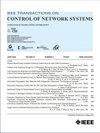Discrete-Time Formation Control With Attitude Alignment: A Geometric Approach Under Ergodic Products
IF 5
3区 计算机科学
Q2 AUTOMATION & CONTROL SYSTEMS
引用次数: 0
Abstract
Assuming agents possess sensing capabilities and dynamics relative to their body coordinate frames, this article addresses a displacement-based strategy for discrete-time formation control through attitude synchronization. Unlike the Eulerian approximation, the first challenge lies in developing discrete-time models that capture both position and attitude motions, thereby complementing existing continuous-time systems with a discretized version. Then, two leader-following control protocols are designed, incorporating a jointly connected topology to relax the connectivity requirements. The analysis of these systems often relies on the Lyapunov function, the existence of which may be hard to guarantee. Consequently, the geometric properties of several polytopes are explored under the dynamic topologies and time-varying parameters. By extending the ergodicity results to leader-following scenarios, these properties are characterized as positively invariant sets. This invariance, which is independent of the existence of the Lyapunov function or the solvability of its associated criteria, provides a beneficial tool for analyzing time-variant systems. Utilizing this invariance and some mathematical techniques, the desired formation shape can be achieved in cases where the attitudes of the followers synchronize with the leader. Finally, a numerical simulation validates the results.具有姿态对准的离散时间编队控制:遍历积下的一种几何方法
假设智能体具有相对于其身体坐标框架的感知能力和动态特性,本文将通过姿态同步解决基于位移的离散时间编队控制策略。与欧拉近似不同,第一个挑战在于开发既能捕获位置和姿态运动的离散时间模型,从而用离散版本补充现有的连续时间系统。然后,设计了两个leader-following控制协议,采用联合连接的拓扑结构,降低了连接要求。这些系统的分析通常依赖于李雅普诺夫函数,而李雅普诺夫函数的存在可能很难保证。因此,在动态拓扑和时变参数下,研究了几种多面体的几何性质。通过将遍历性结果推广到领导跟随场景,这些性质被表征为正不变集。这种不变性与李雅普诺夫函数的存在性或其相关准则的可解性无关,为分析时变系统提供了有益的工具。利用这种不变性和一些数学技巧,在追随者的态度与领导者同步的情况下,可以实现所需的队形。最后,通过数值模拟对结果进行了验证。
本文章由计算机程序翻译,如有差异,请以英文原文为准。
求助全文
约1分钟内获得全文
求助全文
来源期刊

IEEE Transactions on Control of Network Systems
Mathematics-Control and Optimization
CiteScore
7.80
自引率
7.10%
发文量
169
期刊介绍:
The IEEE Transactions on Control of Network Systems is committed to the timely publication of high-impact papers at the intersection of control systems and network science. In particular, the journal addresses research on the analysis, design and implementation of networked control systems, as well as control over networks. Relevant work includes the full spectrum from basic research on control systems to the design of engineering solutions for automatic control of, and over, networks. The topics covered by this journal include: Coordinated control and estimation over networks, Control and computation over sensor networks, Control under communication constraints, Control and performance analysis issues that arise in the dynamics of networks used in application areas such as communications, computers, transportation, manufacturing, Web ranking and aggregation, social networks, biology, power systems, economics, Synchronization of activities across a controlled network, Stability analysis of controlled networks, Analysis of networks as hybrid dynamical systems.
 求助内容:
求助内容: 应助结果提醒方式:
应助结果提醒方式:


